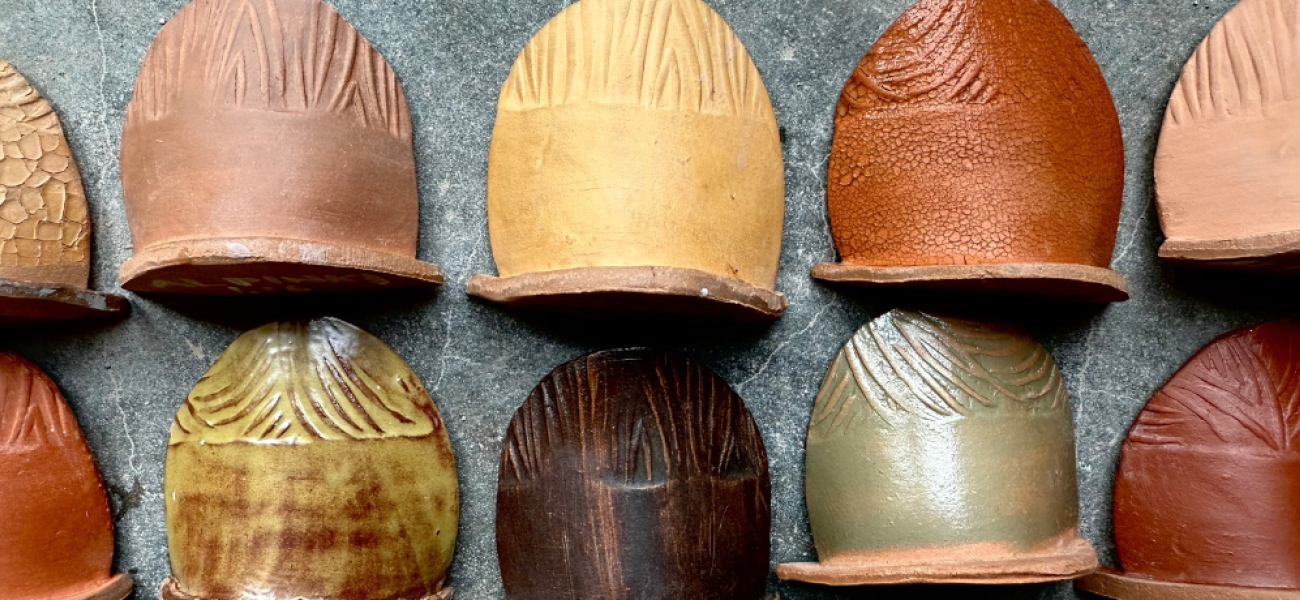Earthen Rainbow: Working with Wild Clay Terra Sigillata at Midrange
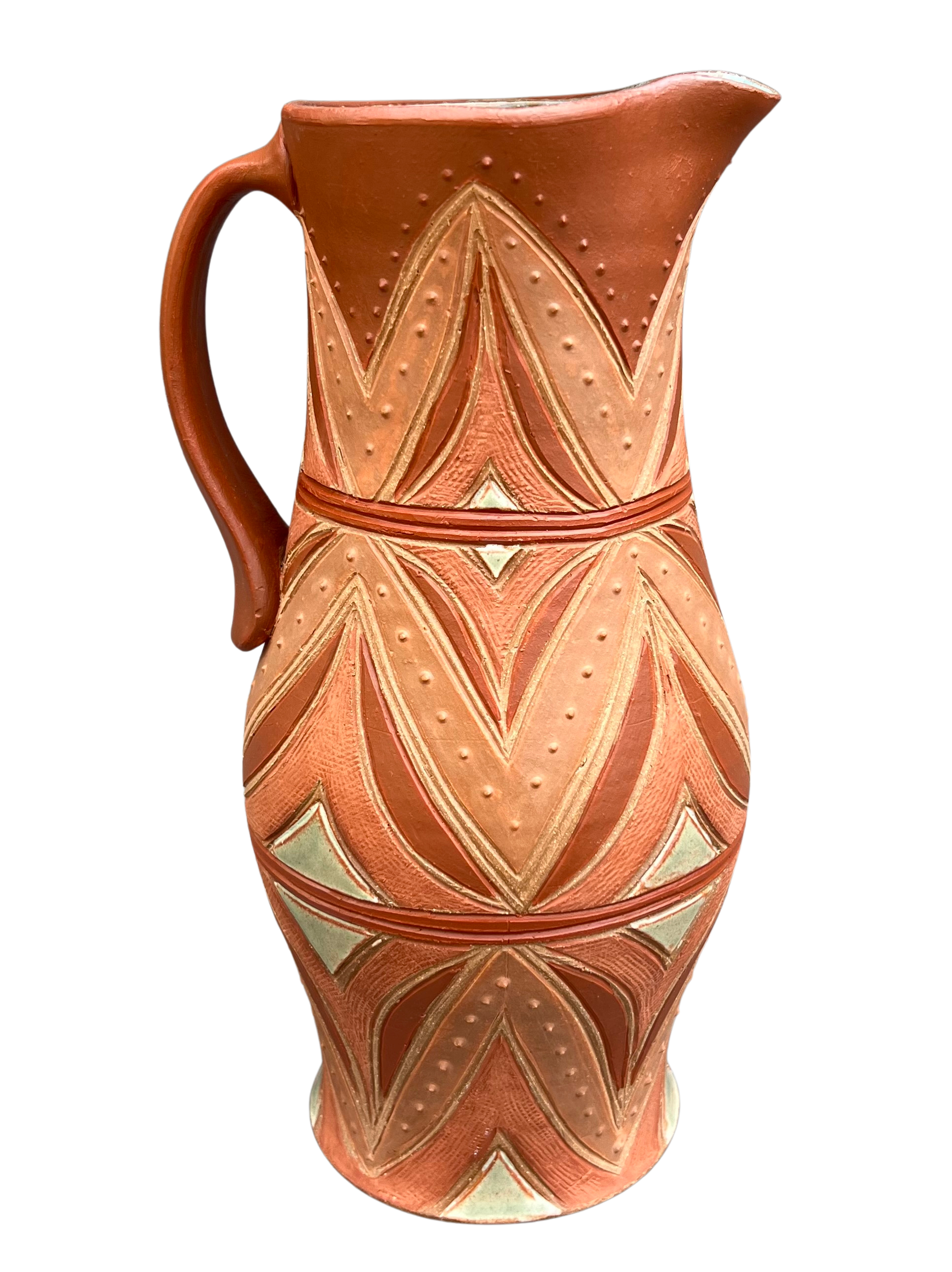 Reconnecting to the Source
Reconnecting to the Source
For a society often disconnected from the natural world, working with wild clays can be a deeply satisfying and enriching experience. The commercialization of clay in the United States has turned the collection and use of foraged clays into a novelty. Here, we have access to a range of manufactured clay bodies, glazes, underglazes, lusters, processed glaze materials, and electric equipment that creates ease for the ceramicist and makes ceramics accessible to hobbyists. However, globally and historically, it's been common practice for ceramic artists to work with clay and other materials that they've collected themselves. So, while the commercial ceramics industry has many benefits for clay enthusiasts, the downside is that we have little connection to the source of our materials. This experience parallels the many ways that we have been made into commercial consumers instead of citizens of the Earth who have a direct relationship with and understanding of the natural world.
Noticing clay in the landscape is the process of rediscovering our environment. The term “wild clay” has gained traction in contemporary ceramics as more artists seek to explore the unique qualities of locally sourced clay. It reflects a growing interest in sustainability, locality, and a deeper connection to nature. Foraging wild clay is not just about finding a material to work with; it’s about engaging with the landscape, understanding the geological history of a place, and honoring the natural processes that formed the clay over thousands of years. Realizing that clay is an abundant natural resource – one that we use not only to make ceramics but also to build our homes and in a number of industrial capacities – inspires deep gratitude to the land and to the Indigenous people who stewarded it for millennia before settlers arrived.
The topic has been beautifully explored in the book Wild Clay: Creating Ceramics and Glazes from Natural and Found Resources by Matt Levy, Takuro Shibata, and Hitomi Shibata. Published in 2020, this book is a seminal resource for ceramicists interested in working with natural materials. Shibata, a Japanese ceramic artist and educator, delves into the practical and philosophical aspects of sourcing, processing, and using wild clay. The book also shares profiles of ceramicists all over the globe, making it an inspiring introduction for artists new to the world of foraged natural materials.
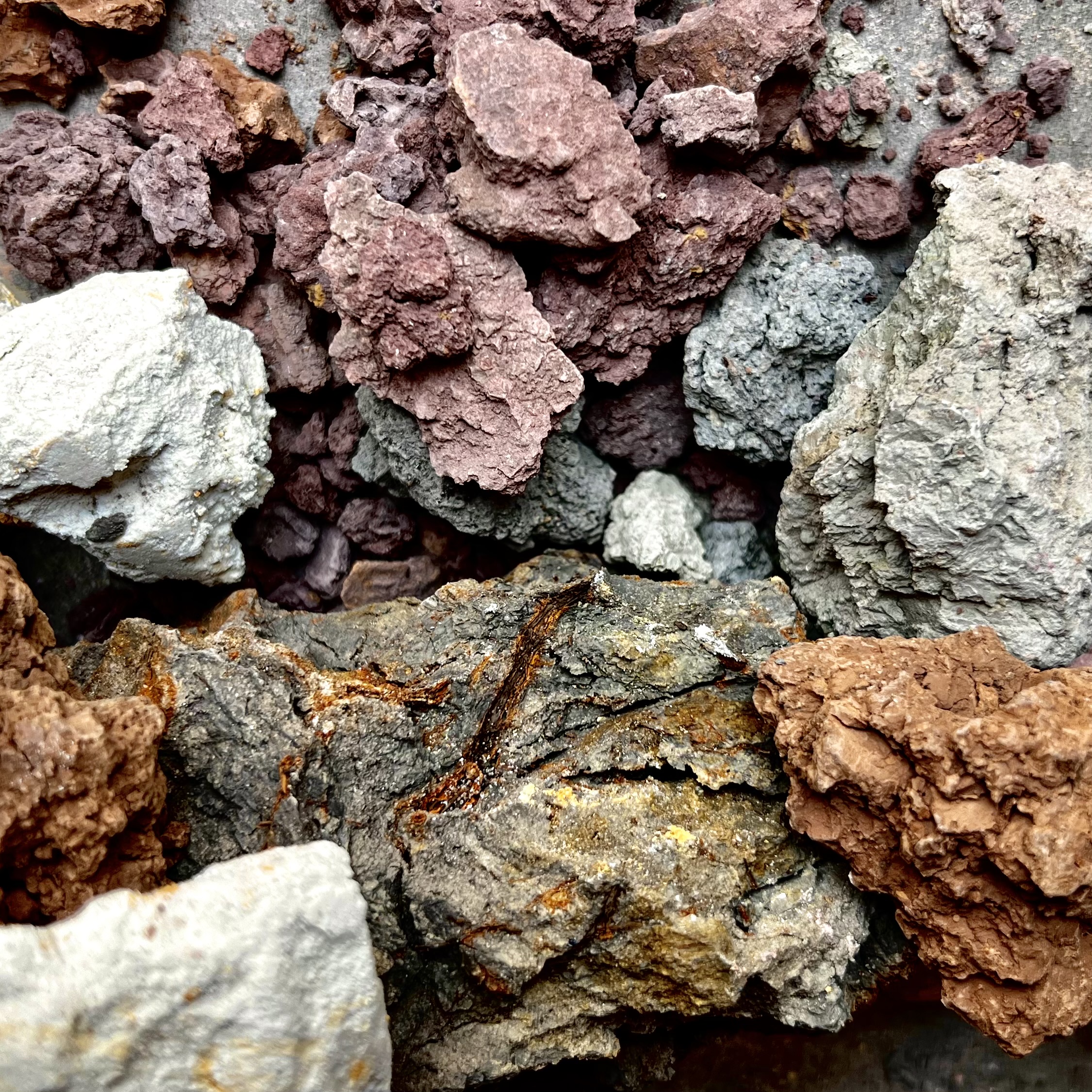 Turning Clay Samples Into Sig
Turning Clay Samples Into Sig
Over the past several years, I’ve been captivated by the process of foraging and test-firing wild clays. One of the most rewarding outcomes of this exploration has been the creation of terra sigillata, a refined clay slip with a rich history and a stunning finish. It’s such a simple process that yields highly individualized and fascinatingly rich results. I’m excited to share my observations and process in the hopes that more people will begin exploring this technique. This is an approachable way of working with wild clay for those who do not have consistent access to large clay deposits or do not have the capability or desire to process large amounts of clay at their home or studio. Depending on the clay, you can make a pint of terra sig with just a one-pound ball of the harvest clay material.
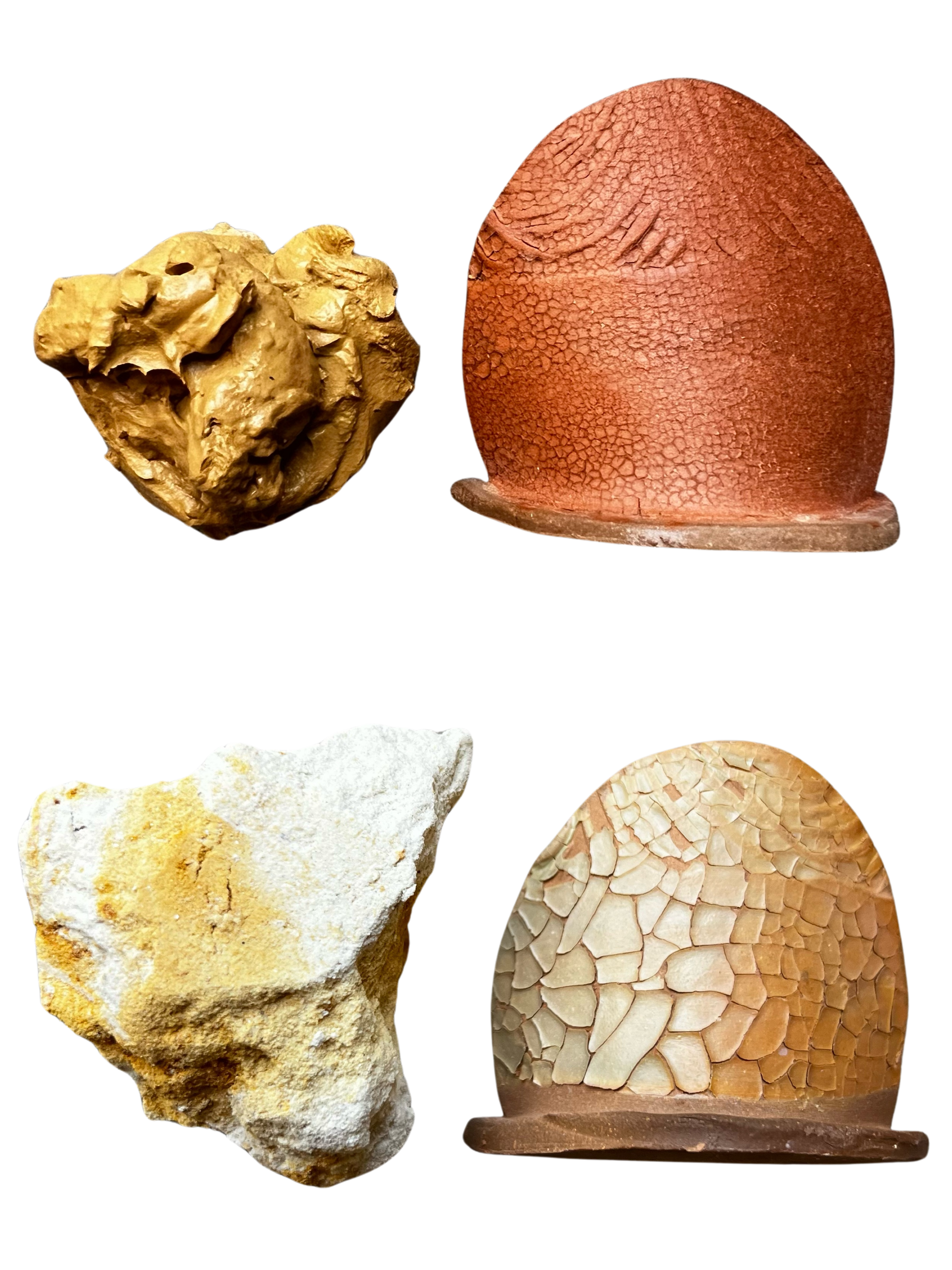 Terra sigillata, meaning "stamped or sealed earth" in Latin, is a type of relief-decorated pottery with a vitrifying slip applied to the surface, a technique developed in Ancient Rome. The term used to refer to the pottery bearing this technique, but has now come to refer to the slip itself. While refining clay by levigating it in water – with or without a deflocculant – is a common practice found in pottery traditions worldwide, the key difference between terra sigillata and other refined slips is that terra sigillata achieves its sheen through vitrification during firing, rather than through burnishing. In many other traditions, refined slips are applied to pottery but still require burnishing to create a smooth, shiny finish. For example, Maria Martinez, the renowned Pueblo potter, applied a refined clay slip to her pots and burnished them several times over to achieve her luminous black-on-black surfaces. By contrast, Roman terra sigillata did not require burnishing because the slip itself vitrified during firing, creating the soft sheen we still admire today.
Terra sigillata, meaning "stamped or sealed earth" in Latin, is a type of relief-decorated pottery with a vitrifying slip applied to the surface, a technique developed in Ancient Rome. The term used to refer to the pottery bearing this technique, but has now come to refer to the slip itself. While refining clay by levigating it in water – with or without a deflocculant – is a common practice found in pottery traditions worldwide, the key difference between terra sigillata and other refined slips is that terra sigillata achieves its sheen through vitrification during firing, rather than through burnishing. In many other traditions, refined slips are applied to pottery but still require burnishing to create a smooth, shiny finish. For example, Maria Martinez, the renowned Pueblo potter, applied a refined clay slip to her pots and burnished them several times over to achieve her luminous black-on-black surfaces. By contrast, Roman terra sigillata did not require burnishing because the slip itself vitrified during firing, creating the soft sheen we still admire today.
Many are surprised to learn that terra sigillata can be used at higher temperatures, though the results differ significantly from low-fire applications. Because of the fine particle size, converting slip into terra sigillata allows for polishing instead of burnishing, but at midrange temperatures, the effects of both polishing and burnishing tend to fade. In this instance, I distinguish between polishing and burnishing based on the level of labor required and the intensity/pressure needed to achieve a shine. Just as with Roman terra sig, the sheen I achieve with my terra sigillata primarily comes from vitrification, not from burnishing or polishing. Since I work with a wide variety of clays, it’s difficult to make blanket statements about their behavior – some clays vitrify to a satin finish, while others develop a semi-gloss sheen. High-fire clays often benefit from polishing when fired to midrange temperatures, whereas low-fire clays tend to melt into a glaze, making polishing unnecessary.
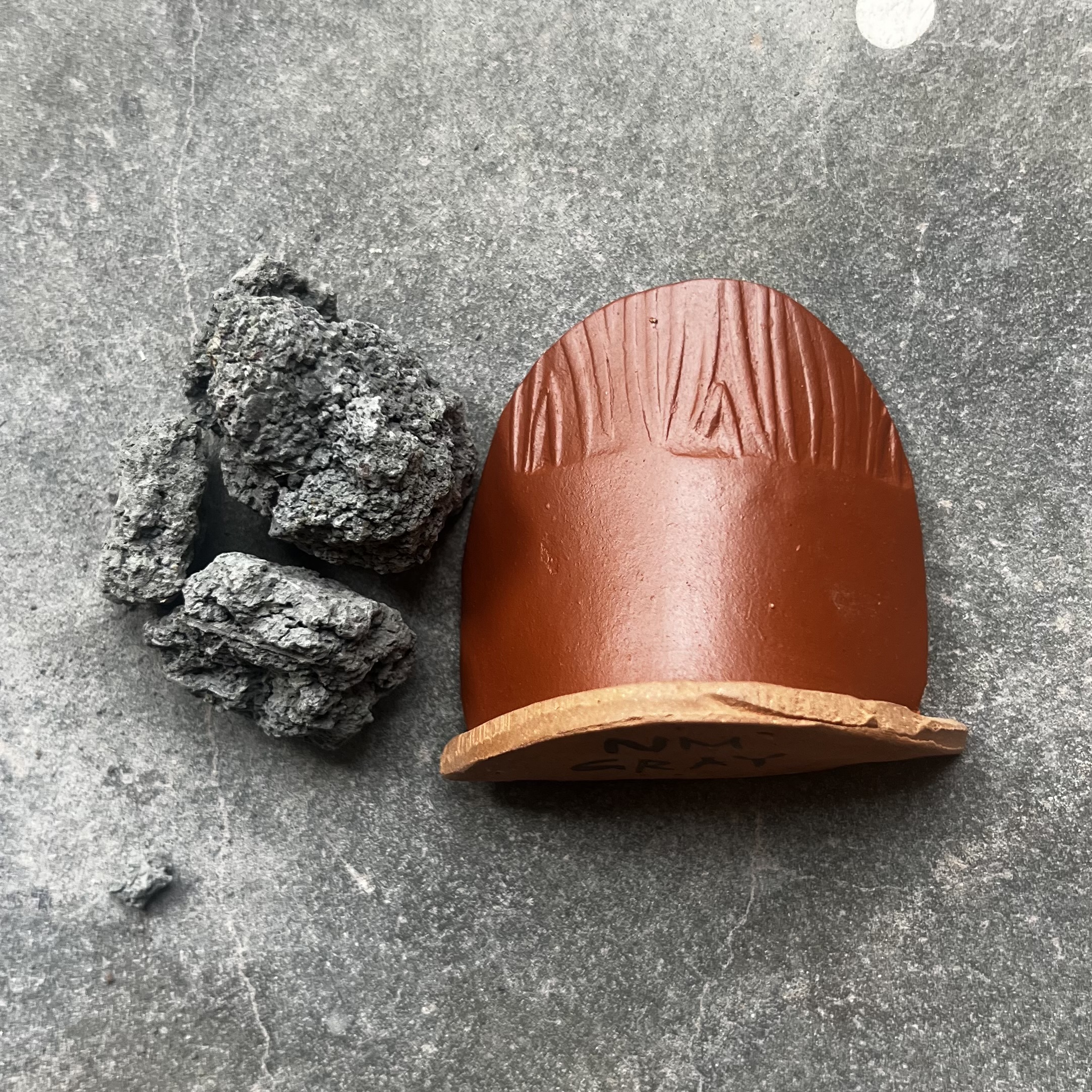 Foraging wild clay is an adventure in itself. It’s a process that begins with curiosity and observation as you learn to identify clay deposits in nature. My first encounter with wild clay was in 2017, in the creek beds and wooded areas outside of Baton Rouge, Louisiana. The clay I found there was smooth, marbled dark pink and white, like a fatty steak. Since then, I’ve found wild clay in various locations, from the Smoky Mountains of Tennessee and the beaches of Cape Cod, to the shores of Sarasota Bay in Florida, where I live now. Each clay deposit has its own unique characteristics – color, texture, plasticity, and firing properties – that make it fascinating to work with. For me, accessing clay in the environment has been a journey of curiosity and respect rather than one of large-scale collection. I usually gather small amounts – sometimes just a pound, other times as much as a grocery bag full – from random locations, always mindful of leaving minimal impact on the environment.
Foraging wild clay is an adventure in itself. It’s a process that begins with curiosity and observation as you learn to identify clay deposits in nature. My first encounter with wild clay was in 2017, in the creek beds and wooded areas outside of Baton Rouge, Louisiana. The clay I found there was smooth, marbled dark pink and white, like a fatty steak. Since then, I’ve found wild clay in various locations, from the Smoky Mountains of Tennessee and the beaches of Cape Cod, to the shores of Sarasota Bay in Florida, where I live now. Each clay deposit has its own unique characteristics – color, texture, plasticity, and firing properties – that make it fascinating to work with. For me, accessing clay in the environment has been a journey of curiosity and respect rather than one of large-scale collection. I usually gather small amounts – sometimes just a pound, other times as much as a grocery bag full – from random locations, always mindful of leaving minimal impact on the environment.
At first, I collected these samples without any specific goal in mind, driven purely by a fascination with the material and its natural origins. Even when opportunities arose to collect larger quantities, my studio wasn’t equipped to process such volumes, so I continued to build a backstock of small, diverse samples. Over time, I began transforming these samples into terra sigillata, and now my studio is filled with dozens of glass jars, each containing a unique, earthy hue. What’s fascinating is that even when I’ve returned to the same site to collect more clay, I’ve often encountered different types, underscoring the vast variety of clay in nature. While some potters find stability and reliability in large, consistent clay deposits they can draw from for years; my experience has been one of discovery and diversity. The collection of these varied samples has highlighted the seemingly infinite variety inherent in nature and the boundless creative possibilities it offers.
Working with wild clay terra sigillata at midrange temperatures is a way to celebrate and honor this infinite variety. In its raw state, clay can appear in a range of colors – blue, gray, orange, pink, yellow, green – often indicating the presence of iron. When fired at low temperatures, these diverse hues tend to flatten into a common iron red or dark orange. However, firing to midrange temperatures (in my case, cone five) allows some clays to melt, vitrify, and develop unique characteristics, moving beyond that initial phase. While the most common result I’ve achieved is a dark, semi-gloss iron red, I’ve also been able to uncover an incredible variety of tones beyond that. Pushing the firing temperature into the high range would likely cause many of these clays to turn brown, potentially losing the subtle variations I’ve come to appreciate. I haven’t tested this yet, as I primarily work with midrange materials, but the results at cone five have been rich and rewarding, showcasing the depth and diversity of wild clay.

Sig Tips & Recipes
Here are some technical tips for creating terra sigillata from wild clays. First, it’s important to understand that not every clay will yield a usable result – curiosity, rather than guaranteed success, is the driving force behind this approach. When I encounter undesired outcomes, such as unwanted crawling, I do a limited amount of troubleshooting, like trying a thinner application or mixing that clay with fire clay, but if I don’t get my desired results after a second round of tests, I simply move on to a different clay altogether. With so many diverse clays available in the landscape, each offering unique results, it hasn’t felt worthwhile to me to struggle with any single clay. The beauty of this method is its non-technical nature. While some knowledge of glaze chemistry and ceramic materials is helpful, I primarily embrace whatever nature provides, seeking an easeful and enjoyable experience in the studio.
Second, pre-processing your clay can often be beneficial before making terra sigillata. Here in Florida, for example, our clays are often very sandy, so I sieve them to remove larger sand particles, which increases the yield for terra sig. I also do this with clays that contain rocks or plant roots. However, when working with clays that are naturally pure, fine-particle, and smooth, I often skip processing altogether and make terra sigillata directly from the raw material. If you’re not sure about the quality of your clay, go ahead and pre-process it using any sieve you have on hand. One hundred mesh is probably the best option, but even sieving to sixty mesh will help. I use generic sig recipes that one would use for commercial clays like Redart. However, when using wild clays, be aware that the separated layers you get may be quite different from what you get when you use commercially processed clays, which are already highly refined. For instance, Redart is air-floated and will give you a much higher yield of terra sigillata than any clay that I could forage locally in Florida. Be prepared for clays to behave in unexpected ways while you work with them.
 I apply two to four coats of sig, depending on the clay. During the testing phase, I keep track of the specific gravity and number of coats that work best for each clay. I mark this information on the bottom of each test tile. When I’m ready to decorate a piece, I lay out my test tiles on a table and play with color combinations that I find pleasing and beautiful. I work toward a rhythmic and harmonious balance of color, working symmetrically around my pots. I make cool-color glazes like blue and green that I use as accents to complement the mostly warm clay earth tones. I only use terra sig as exterior surface decoration – even the ones that turn into glaze. I use a food-safe liner glaze for my interiors.
I apply two to four coats of sig, depending on the clay. During the testing phase, I keep track of the specific gravity and number of coats that work best for each clay. I mark this information on the bottom of each test tile. When I’m ready to decorate a piece, I lay out my test tiles on a table and play with color combinations that I find pleasing and beautiful. I work toward a rhythmic and harmonious balance of color, working symmetrically around my pots. I make cool-color glazes like blue and green that I use as accents to complement the mostly warm clay earth tones. I only use terra sig as exterior surface decoration – even the ones that turn into glaze. I use a food-safe liner glaze for my interiors.
Making Terra Sigillata
(Adapted from Kip O’Krongly’s recipe given to me by Jen Allen in 2016)
-
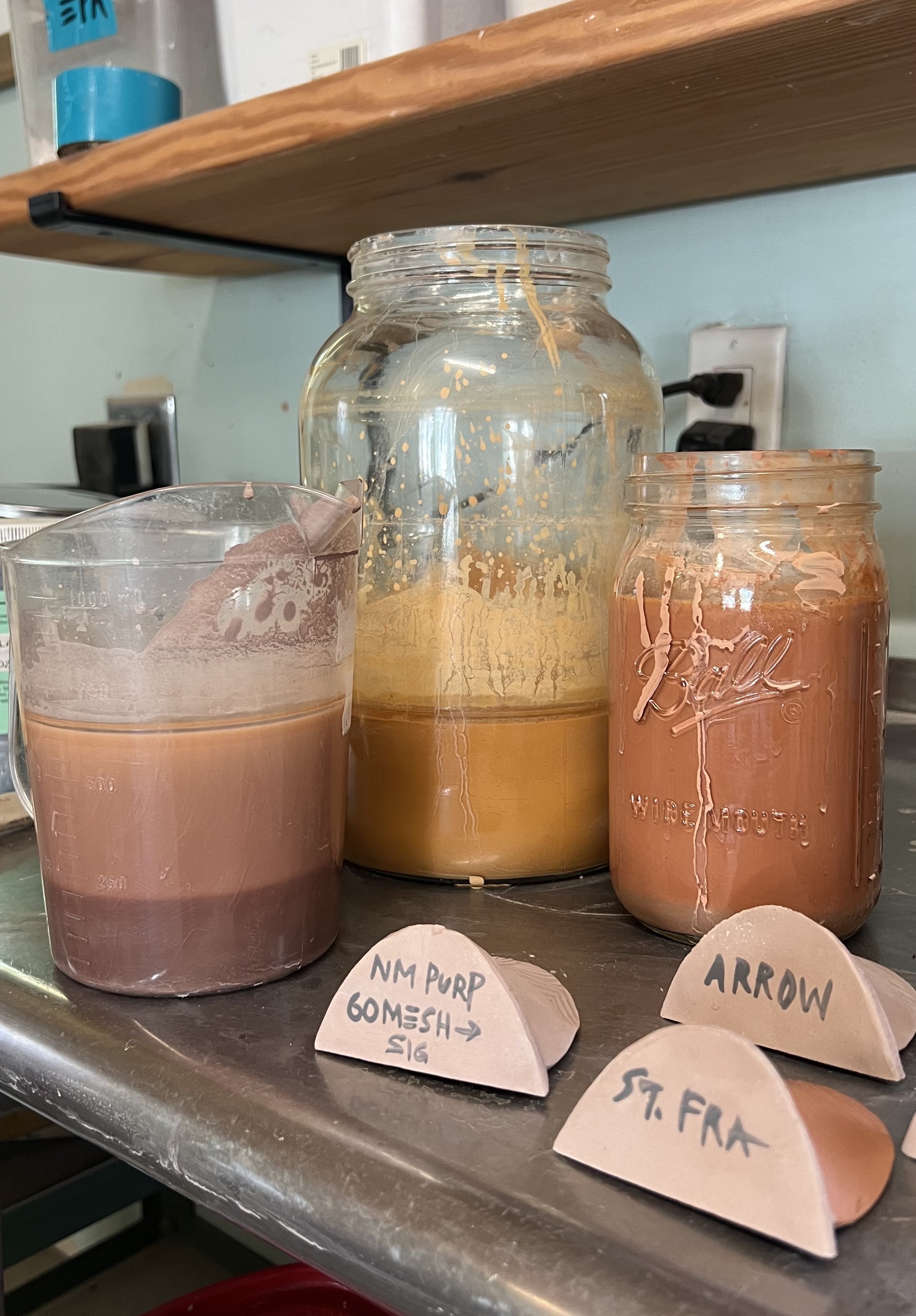
In a large glass jar, mix 2800 mL water and 6.6 ml Sodium Silicate together. Blunge these together with a stick blender.
- Next, add 1200 grams of clay and blunge thoroughly with the stick blender.
- Let the glass jar sit undisturbed for twenty-four to seventy-two hours. You should start to see layers separating out after just an hour or so. The layers will be more distinct by the next day. Depending on the clay, I usually get two to three visible layers. Siphon off the layer of liquid between the thin layer of water on top and the layer(s) of sludge or sand on the bottom. I use a 200mL or 500mL plastic syringe.
- Simmer the siphoned layer on the stovetop until you reach a specific gravity of between 1.15 and 1.18. This means that 100 ml of terra sig will weigh between 115 and 118 grams. I weigh my syringe, tare the scale, fill the syringe to 100mL, and weigh it.
- For the best results, apply terra sig to bone-dry clay. I apply two to four coats, depending on the clay. Be careful not to go too thick, as that often leads to crawling and flaking.
A Both/And Approach in the Studio
I also want to clarify that I still use manufactured clay to form my pieces, reserving wild clay primarily for decoration. Additionally, I sometimes use commercially processed clays like Redart and Newman Red to create terra sigillata. While I often compare using wild clay to growing your own vegetables instead of buying them from the store – which might suggest a preference – my approach is actually both/and, not either/or. Just as I supplement my garden harvest with store-bought produce and other staples, I blend wild and manufactured materials in my pottery practice. Because of my experimentation with wild clay, I’ve developed a deeper appreciation for the effort and expertise involved in creating manufactured clay bodies. I’ve gained a greater understanding of mining processes and the work required to transform raw materials into consistent, predictable clay bodies. My studio practice thrives on the combination of materials from diverse sources, and I feel incredibly fortunate to have access to globally sourced materials that enrich my work.
However, we’ve seen the rising costs and environmentally unsustainable practices associated with mining, including the harsh impacts on laborers involved in extracting materials like lithium and cobalt. The mining of cobalt in regions like the Congo is plagued by severe human rights abuses, including child labor, unsafe working conditions, and environmental degradation, all of which highlight the ethical and ecological costs of our reliance on this critical mineral. The price of lithium has surged in recent years due to skyrocketing demand for electric vehicles and renewable energy storage, coupled with limited supply and the challenges of scaling up sustainable mining operations.
Incorporating wild materials into our studio practice could be a step toward reducing our reliance on purchased materials and sourcing clay in a more sustainable way. That said, it’s important to recognize that while you may save money, you’ll invest additional time in processing and testing these materials. These are all factors worth considering as we balance sustainability, cost, and effort in our work.
Clay & Culture
My pottery is deeply inspired by global Indigenous and ancestral pottery traditions, particularly those from Nigeria, where my parents are from. I draw from historical forms, such as Ladi Kwali’s iconic Gwari water pots and Nupe pottery, which I’ve referenced for years while decorating with glazes. My goal has been to blend ancestral, Indigenous ways of making with the context of contemporary studio pottery. I envision the Abuja Pottery Center as a symbolic starting point for my practice, where traditional coil-building and decorating techniques, made famous by Ladi Kwali, intersect with wheel-throwing, glazing, and firing technologies introduced to Nigeria by Michael Cardew.
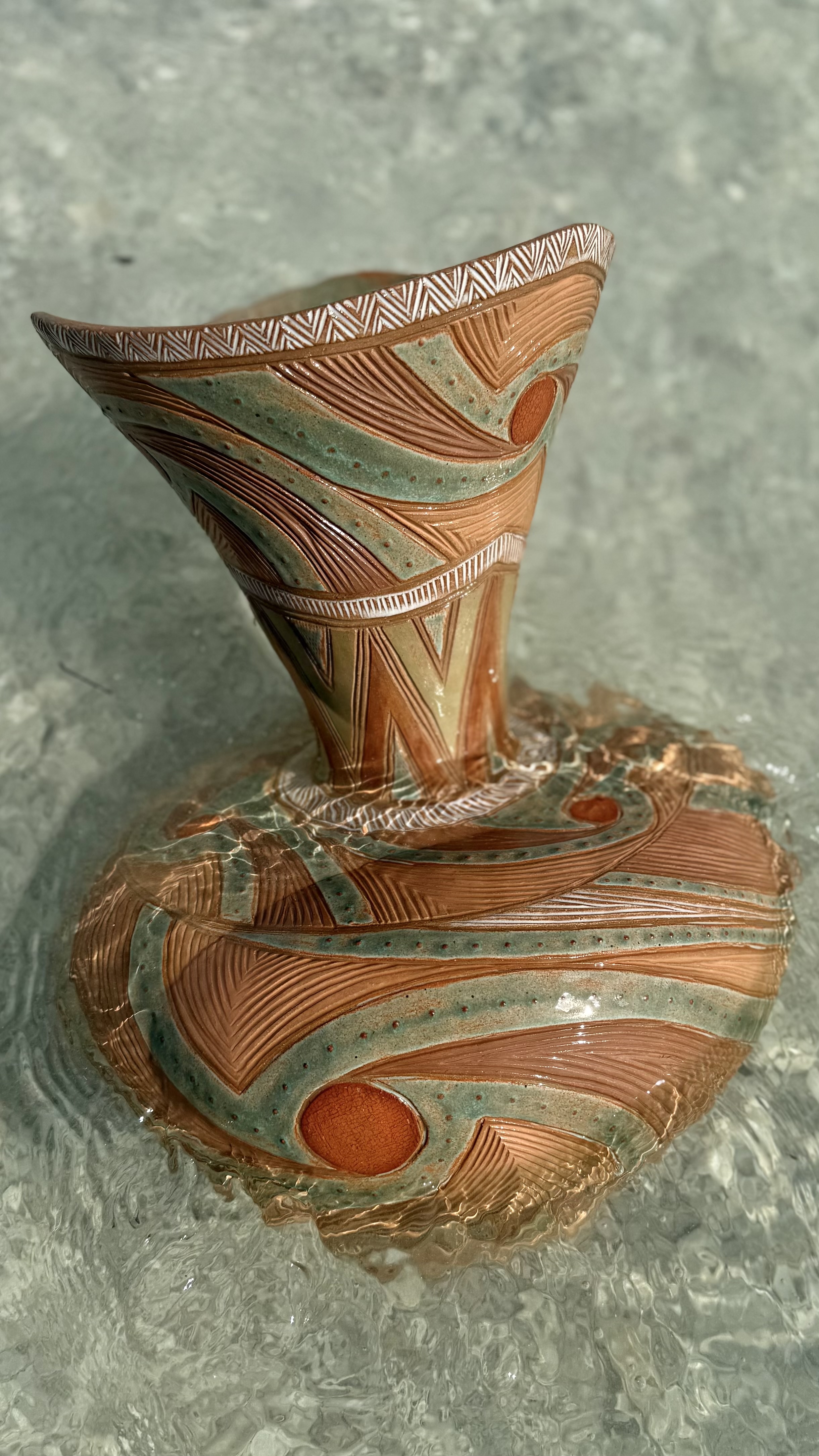 While the work Ladi Kwali became internationally known for was glazed (unlike traditional Nigerian pottery, which was unglazed and better functioning for that reason), I eventually felt that the glazes I used didn’t quite align with my vision. Introducing wild clay terra sigillata to my African-inspired forms bridged an aesthetic gap for me. Using foraged and hand-processed materials connects my work to indigenous methods of making. At the same time, the effects I achieve firing to midrange temperatures in an electric kiln are distinctly contemporary – unlike anything seen in traditional African ceramics.
While the work Ladi Kwali became internationally known for was glazed (unlike traditional Nigerian pottery, which was unglazed and better functioning for that reason), I eventually felt that the glazes I used didn’t quite align with my vision. Introducing wild clay terra sigillata to my African-inspired forms bridged an aesthetic gap for me. Using foraged and hand-processed materials connects my work to indigenous methods of making. At the same time, the effects I achieve firing to midrange temperatures in an electric kiln are distinctly contemporary – unlike anything seen in traditional African ceramics.
The defining element of Indigenous cultures is a deep connection to place and land – a bond I will never fully comprehend. As the child of immigrants who has moved multiple times throughout my life, I often feel a sense of displacement. Collecting clay has helped heal this feeling in some ways. I know Florida better than I know any place I’ve ever lived, and I’ve only been here for five years. Beyond learning to identify certain plants and animals, I’ve gained a deeper understanding of Florida’s geology by gathering clay from the environment. Whenever I use a specific terra sigillata, I recall the exact location where I collected the clay or, if it was a gift, the person who gave it to me. When I look at the finished pieces, I see the stories carved into them: my travels, my studies, my husband’s support, and the countless individuals who have shared techniques and knowledge with me over the years. In this way, the pots become more than just self-expression – they transform into a communal, land-based narrative.

